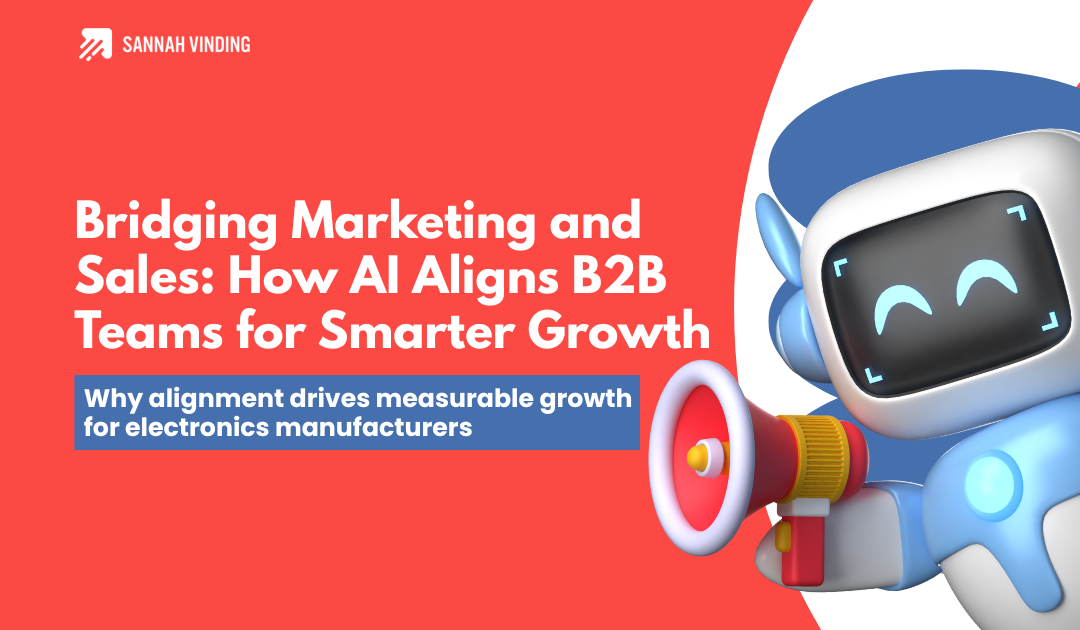Why alignment drives measurable growth for electronics manufacturers
From Alignment to Acceleration
In manufacturing, marketing and sales share a common goal: growth. Yet, these two functions often operate in silos, with marketing focused on awareness and sales focused on conversion. As B2B buyers rely more on AI-driven research and self-service decision-making, the need for alignment has never been greater.
AI is now bridging that gap. By analyzing intent data, automating lead scoring, and providing real-time insights, AI helps marketing and sales teams work from the same playbook. For manufacturers, this means smarter engagement, higher-quality leads, and faster conversions.
According to SalesLion, 77% of B2B buyers conduct independent research before contacting sales, which means AI-enabled marketing must reach and nurture customers long before a conversation begins.
77% of B2B buyers conduct independent research before contacting sales.
Source SalesLion
The shift from funnel thinking to customer intelligence
Traditional B2B funnels are no longer linear. Engineers and procurement professionals move between channels, platforms, and devices, often using AI tools to compare suppliers or validate specifications before talking to anyone on your team.
A recent 6sense study found that 70% of the buyer journey now happens before direct contact with vendors. AI gives marketing and sales shared visibility into these early behaviors, revealing where customers are in their decision process and how best to engage them.
Predictive analytics highlight who is ready to buy, while content recommendations ensure the right message appears at the right moment. This shift turns marketing and sales teams from reactive to proactive, anticipating customer needs rather than responding to them.
70% of the buyer journey now happens before direct contact with vendors.
Source: 6Sense
Breaking down silos through shared AI systems
AI platforms that integrate CRM, marketing automation, and analytics are changing how manufacturing organizations operate. Instead of separate reporting tools, unified dashboards give both marketing and sales real-time visibility into performance, pipeline, and engagement.
When everyone works from the same data, decisions become faster and more precise. Marketing can optimize campaigns based on lead quality, while sales can prioritize outreach based on verified interest.
This collaboration transforms marketing from a support function into a strategic revenue driver.
More than 70% of buyers wait to contact sellers until late in the process.
Source: PPAI
Balancing AI automation with the human touch
AI is powerful, but it is not a replacement for relationships. In B2B manufacturing, trust still comes from people, from engineers, sales reps, and technical experts who understand the challenges buyers face.
AI can automate workflows, optimize campaigns, and uncover insights, but human creativity and empathy turn that data into connection. The strongest organizations use AI to amplify expertise and authenticity, not replace them.
A PPAI study found that more than 70% of buyers wait to contact sellers until late in the process, reinforcing the need for marketing to establish trust and authority early. AI can support that effort, but it is the human element that makes it real.
Growth happens when marketing and sales move together
AI is not just changing how marketing and sales operate. It is uniting them around shared intelligence, measurable outcomes, and customer understanding.
For manufacturers, this alignment is the foundation for growth in an AI-first market. When marketing and sales collaborate through AI, every customer interaction becomes smarter, faster, and more meaningful.
Follow for real strategies, not theory, insights from the manufacturing front line

